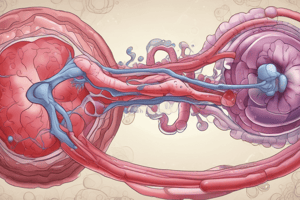Podcast
Questions and Answers
Describe two mechanisms, apart from anti-GBM antibodies, that can lead to the development of characteristic findings in Type II RPGN.
Describe two mechanisms, apart from anti-GBM antibodies, that can lead to the development of characteristic findings in Type II RPGN.
Immune complex deposition and pauci-immune mechanisms.
What specific disease exemplifies immune complex deposition in Type II RPGN?
What specific disease exemplifies immune complex deposition in Type II RPGN?
SLE
What specific disease exemplifies pauci-immune mechanisms in Type II RPGN?
What specific disease exemplifies pauci-immune mechanisms in Type II RPGN?
Granulomatosis with polyangiitis (Wegener's)
What is the diagnosis based on the findings of diffuse thickening of the basement membrane, prominent capillary loops, but no increased cellularity in light microscopy, along with subepithelial deposits and basement membrane reaction in electron microscopy?
What is the diagnosis based on the findings of diffuse thickening of the basement membrane, prominent capillary loops, but no increased cellularity in light microscopy, along with subepithelial deposits and basement membrane reaction in electron microscopy?
What is the significance of the 5.5 g of protein in the 24-hour urine test and serum albumin of 29g/L in the clinical presentation?
What is the significance of the 5.5 g of protein in the 24-hour urine test and serum albumin of 29g/L in the clinical presentation?
How does the appearance of spikes on Jones silver stain relate to the diagnosis of membranous glomerulopathy?
How does the appearance of spikes on Jones silver stain relate to the diagnosis of membranous glomerulopathy?
What is the characteristic location of deposits in poststreptococcal glomerulonephritis?
What is the characteristic location of deposits in poststreptococcal glomerulonephritis?
What is the main complication associated with rapidly progressive glomerulonephritis?
What is the main complication associated with rapidly progressive glomerulonephritis?
What differentiates postinfectious glomerulonephritis due to staphylococcal infections from streptococcal infections?
What differentiates postinfectious glomerulonephritis due to staphylococcal infections from streptococcal infections?
What are the 3 types of Rapidly Progressive (Crescentic) Glomerulonephritis?
What are the 3 types of Rapidly Progressive (Crescentic) Glomerulonephritis?
What is the hallmark feature of Renal limited Goodpasture syndrome?
What is the hallmark feature of Renal limited Goodpasture syndrome?
What diagnostic tools are used to diagnose poststreptococcal glomerulonephritis?
What diagnostic tools are used to diagnose poststreptococcal glomerulonephritis?
What are the key structures highlighted in a normal glomerulus in a H + E stain?
What are the key structures highlighted in a normal glomerulus in a H + E stain?
How can glomerular disorders be classified based on the extent of organ involvement?
How can glomerular disorders be classified based on the extent of organ involvement?
List three techniques used to evaluate glomeruli in glomerular disorders.
List three techniques used to evaluate glomeruli in glomerular disorders.
What are the main manifestations of glomerular disorders?
What are the main manifestations of glomerular disorders?
Define 'Segmental' involvement in glomerular disorders.
Define 'Segmental' involvement in glomerular disorders.
Explain the term 'Global' in the context of glomerular disorders.
Explain the term 'Global' in the context of glomerular disorders.
What are the clinical features of nephritic syndrome?
What are the clinical features of nephritic syndrome?
Describe the clinical features of nephrotic syndrome.
Describe the clinical features of nephrotic syndrome.
What is the glomerular reaction pattern seen in crescentic glomerulonephritis?
What is the glomerular reaction pattern seen in crescentic glomerulonephritis?
Which glomerular disease is associated with matrix accumulation in mesangium and GBM with glomerulosclerosis?
Which glomerular disease is associated with matrix accumulation in mesangium and GBM with glomerulosclerosis?
What are the clinical features of post-infectious glomerulonephritis?
What are the clinical features of post-infectious glomerulonephritis?
Which glomerular disease is associated with minimal change glomerulopathy?
Which glomerular disease is associated with minimal change glomerulopathy?
What is the pathophysiological basis of massive proteinuria in nephrotic syndrome?
What is the pathophysiological basis of massive proteinuria in nephrotic syndrome?
How does hypoalbuminemia develop in nephrotic syndrome?
How does hypoalbuminemia develop in nephrotic syndrome?
Explain the mechanism behind the development of edema in nephrotic syndrome.
Explain the mechanism behind the development of edema in nephrotic syndrome.
What are some common causes of secondary membranous glomerulopathy?
What are some common causes of secondary membranous glomerulopathy?
What clinical features were observed in the 2-year-old Malaysian male with nephrotic syndrome?
What clinical features were observed in the 2-year-old Malaysian male with nephrotic syndrome?
What is the significance of proteinuria ++++ in the urinalysis of the 2-year-old Malaysian male?
What is the significance of proteinuria ++++ in the urinalysis of the 2-year-old Malaysian male?
Flashcards are hidden until you start studying



